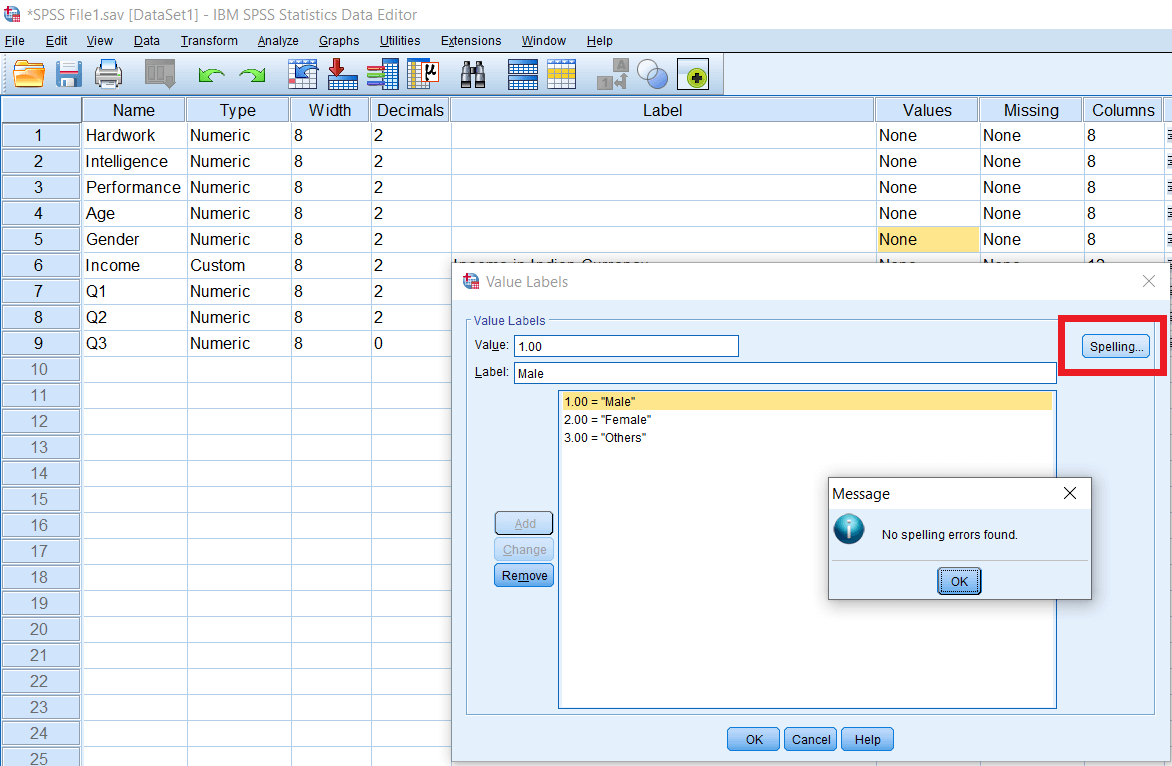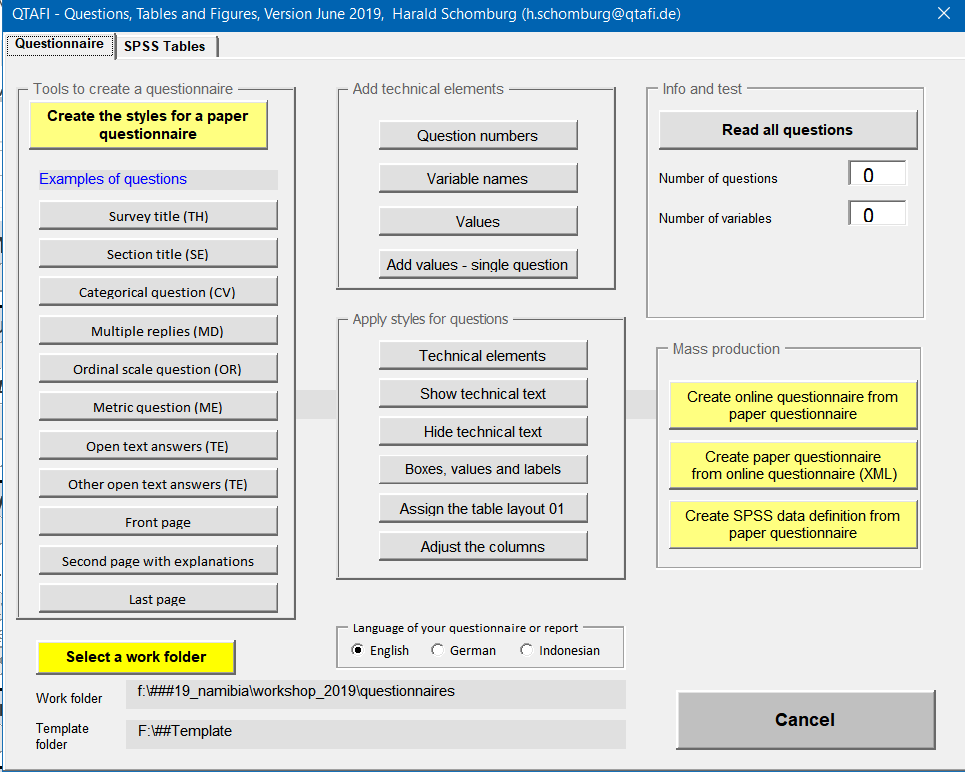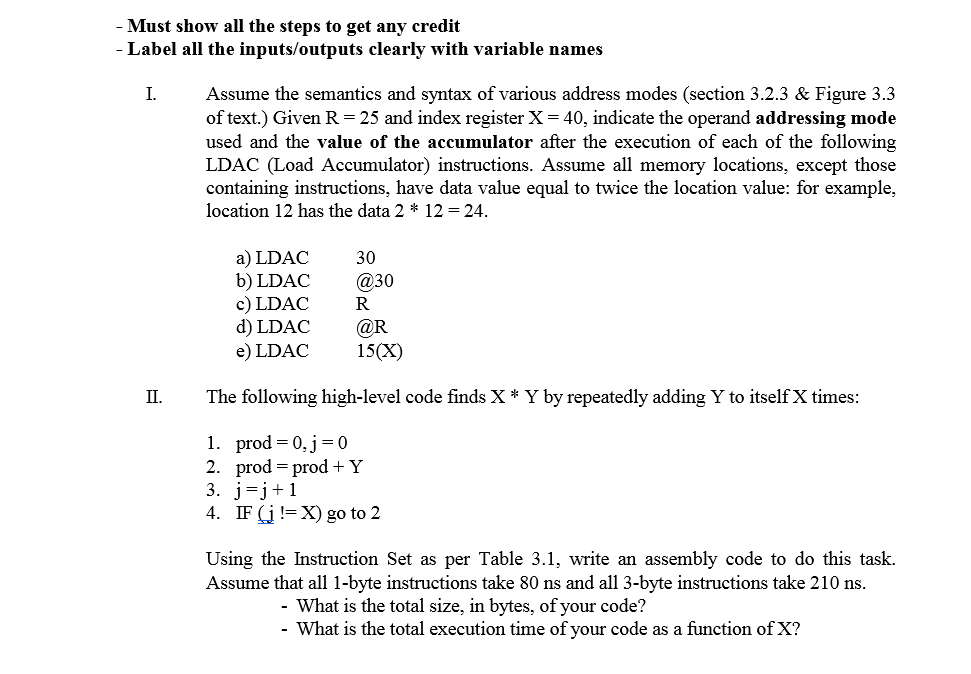43 spss value labels range
Defining Variables - SPSS Tutorials - Kent State University The Value Labels window appears. Type the first possible value (1) for your variable in the Value field. In the Label field type the label exactly as you want it to display (e.g., "Freshman"). Click Add when you are finished defining the value and label. Your variable value and label will appear in the center box. SPSS Variable and Value Labels: A Quick Tutorial - Alchemer VALUE LABELS / var503 TO var504 0 'Unchecked' 1 'Checked' / var603 TO var605 1 "Couldn't care less" 2 'Somewhat devoted' 3 "Can't live w/o it!" Hint: I typically like leaving the period on its own line. This gives me a nice, clear, visual reminder of where my command stops running.
PDF SPSS handout 3: Grouping and Recoding Variables - statstutor New Value select Copy old value(s). Click on Add. 5 Click on Continue then OK. 4 Recoding a categorical or ordinal variable Again, this is done in a similar way to that described above: 1 Follow steps 1 to 3 as previously. 2 Under Old Value select Value and enter one of the old codes. Under New Value select Value and type in the corresponding ...

Spss value labels range
Copy variable and value labels and SPSS-style missing value This function copies variable and value labels (including missing values) from one vector to another or from one data frame to another data frame. For data frame, labels are copied according to variable names, and only if variables are the same type in both data frames. Using Syntax to Assign 'Variable Labels' and 'Value Labels' in SPSS Here are the steps to assign variable labels: Open a new syntax window by clicking through the following menu path ( see below ): File->New->Syntax. Type the command "VARIABLE LABELS" (be careful of spelling). On the next line (new line not required, but recommended), first type the name of the variable you want to assign a label to (in my ... How to Use DBSCAN Effectively - Towards Data Science Mar 25, 2020 · Latter refers to the number of neighbouring points required for a point to be considered as a dense region, or a valid cluster. Usually, we set this to a value that makes sense for the dataset and the number of dimensions present in the data. This will determine the number of outliers identified. However, this parameter is not as crucial as eps.
Spss value labels range. SPSS - Set Variable Labels with Syntax SPSS Value Labels Syntax Examples (The test data used by the syntax below are found here .) *1. Apply single value label. Note how it appears under Variable View. value labels married 1 'Never married'. *2. Wrong way for adding/changing value labels. This removes the value label we added in the previous command. value labels married 2 'Married'. Value Labels - SPSS - YouTube Using both the menu driven approach as well as syntax, I demonstrate how to create value labels for variables in SPSS. Group data and define corresponding value labels | Raynald's SPSS Tools * Load data file then call this macro. * vname =name of variable to be recoded. * vcoded =name of variable which is to contain recoded value. * begr =BEGinning of first Range. * endr =ENDing of first Range (4 means 4.9999999...). * diff =display the endr as endr + 1 - diff. * nbbins =NumBer of BINS. * nbbins. begr and endr must be integers. SPSS Value and Labels - javatpoint SPSS Value and Labels In this section, we will learn the Values option. Values are used to indicate the Labels of variables. For example, if we have Gender as a variable, Gender has male and female labels.
Display Value Labels in SPSS - Easy SPSS Tutorial Quick Steps Click on tab to display Variable View Identify your variable, click on its cell in the Values column, and then click on the ellipsis Enter your first coded numerical value where it says Value, and the label you want associated with that value where it says Label Press Add, and then repeat for all further numerical values Finding & Excluding Outliers in SPSS - 3 Easy Options The problem here is that you can't specify a low and a high range of missing values in SPSS. Since this is what you typically need to do, this is one of the biggest stupidities still found in SPSS today. A workaround for this problem is to. RECODE the entire low range into some huge value such as 999999999;; add the original values to a value label for this value; Value labels - IBM You can assign descriptive value labels for each value of a variable. This process is particularly useful if your data file uses numeric codes to represent non-numeric categories (for example, codes of 1 and 2 for male and female). Value labels are saved with the data file. You do not need to redefine value labels each time you open a data file. 10.8 Changing the Labels in a Legend - R Graphics 10.8.3 Discussion. Note that the labels on the x-axis did not change. To do that, you would have to set the labels of scale_x_discrete() (Recipe 8.10), or change the data to have different factor level names (Recipe 15.10).. In the preceding example, group was mapped to the fill aesthetic.
The labelled_spss_survey class • retroharmonize The SPSS variables do not handle various missing cases in a complete and unambiguous form. In an age variable, 998 and 999 may be labelled as not asked and declined to answer, or simply the numerical range between 120-999 may be marked as a range of numeric values representing missing cases. Learn to Interpret Factor Loadings in SPSS With Data From the Opinions ... You will also be prompted to provide your new variable with a name and label. The name has been provided with the same as the original and added reverse code to highlight it is the new variable. The label has been provided with the same as the original. Figure 2 shows what this looks like in SPSS. Finding & Excluding Outliers in SPSS - 3 Easy Options Since this is what you typically need to do, this is one of the biggest stupidities still found in SPSS today. A workaround for this problem is to. RECODE the entire low range into some huge value such as 999999999; add the original values to a value label for this value; specify only a high range of missing values that includes 999999999. The Values Column of the SPSS Variable View Tab - dummies The Values column in the SPSS Variable View tab is where you assign labels to all the possible values of a variable. If you select a cell in the Values column, a button with three dots appears. Clicking that button displays the dialog box shown here. /uploads/485341.image0.jpg" height="299" alt="You can assign a name to each possible value of a variable."
Labelled vectors for SPSS — labelled_spss • haven This class is only used when user_na = TRUE in read_sav (). It is similar to the labelled () class but it also models SPSS's user-defined missings, which can be up to three distinct values, or for numeric vectors a range. Usage labelled_spss( x = double (), labels = NULL, na_values = NULL, na_range = NULL, label = NULL ) Arguments x
Defining Variables - SPSS Tutorials - LibGuides at Kent State … 24.5.2022 · Written and illustrated tutorials for the statistical software SPSS. Variable definitions include a variable's name, type, label, formatting, role, and other attributes. This tutorial shows how to define variable properties in SPSS, especially custom missing values and value labels for categorical variables.
Creating a bar chart using SPSS Statistics - Laerd Note: The procedure above is intended to make the y-axis show a suitable range of values for coping_stress.These values might be different for your variables, so you should adjust them as you see fit. If you are not sure at first what these values should be, don't change the values; see what the simple bar chart looks like and then re-run the simple bar chart with new axes values if necessary.
Defining Value Labels and Other Variable Properties - IBM Click the Unlabeled column heading under Scanned Variable List. You can also sort by variable name or measurement level by clicking the corresponding column heading under Scanned Variable List. Value Label Grid Label. Displays any value labels that have already been defined. You can add or change labels in this column. Value.
Variable Labels and Value Labels in SPSS - The Analysis Factor But by having Value Labels, your data and output still give you the meaningful values. Once again, SPSS makes it easy for you. 1. If you’d rather see Male and Female in the data set than 0 and 1, go to View–>Value Labels. 2. Like Variable Labels, you can get Value Labels on output, along with the actual values. Just go to Edit–>Options.
Variable Labels and Value Labels in SPSS - The Analysis Factor But by having Value Labels, your data and output still give you the meaningful values. Once again, SPSS makes it easy for you. 1. If you’d rather see Male and Female in the data set than 0 and 1, go to View–>Value Labels. 2. Like Variable Labels, you can get Value Labels on output, along with the actual values. Just go to Edit–>Options.
How to Create a Frequency Distribution in Excel - Statology Aug 10, 2020 · 6 values in the dataset are within the range of 0-10. 7 values in the dataset are within the range of 11-20. 5 values in the dataset are within the range of 21-30. 2 values in the dataset are greater than 30. We can then use the following steps to visualize this frequency distribution: Highlight the frequency counts in the range D2:D5.
SPSS Class Notes: Modifying Data - OARC Stats Click on "Variable View" tab (in the lower left corner) for schtyp, type in the label "The type of school the student attended."in the Label column. In the Values column, click on the right of the box for schtyp to open the dialog box type 1 in the Value box and "public" in the Label box, and then click on Add. Do the for the next value label.
Recoding Variables in SPSS Menus and Syntax - The Analysis Factor Old Value: Range: Lowest Through: 11. New Value: Value: 1. Click Add. ... I want to add the codes to spss as value lables and I also need to recode the existing data into 1,2,3,4,etc. ... you definitely want to use syntax to do both. The commands are RECODE and VALUE LABELS. If you look them up in the Command Syntax Reference manual. It's in ...
Recoding Variables in SPSS Statistics - recoding a given range - Laerd Recode a given range in SPSS Statistics. Example: The data given below represents the scores of 10 students in a final examination. Recode the data giving code "1" to scores between 75 - 100, code 2 to scores between 61 - 74, code 3 to scores between 41 - 60 and code 4 to scores between 0 - 40. Final examination scores of 10 students. Scores. 58.
Recoding Variables - SPSS Tutorials - Kent State University Old and New Values. Once you click Old and New Values, a new window where you will specify how to transform the values will appear.. 1 Old Value: Specify the type of value you wish to recode (e.g., a specific value, missing data, or a range of values) and the specific value to be recoded (e.g., a value of "1" or a range of "1-5").. When recoding variables, always handle the missing ...
How to Transform (Recode) Variables in SPSS - bizkapish This is the only difference so we will explain only "Recode into Different Variables" case. First, we choose column to recode (1) and we add it to pane (2). Next, we give name and label to the new column (3,4). After that, we click on the "Change" button (5) and name of the new column will be added to pane (6).
SPSS RANGE Function - Simple Tutorial with Examples SPSS ' RANGE function is used to evaluate whether or not values are within a given range. Test values equal to the lower or upper boundary are also within the given range. Run the syntax below for a quick demonstration. SPSS Range Syntax Example *1. Create couple of cases. data list free/v1 (f1). begin data 1 2 3 4 5 6 end data. *2.











Post a Comment for "43 spss value labels range"